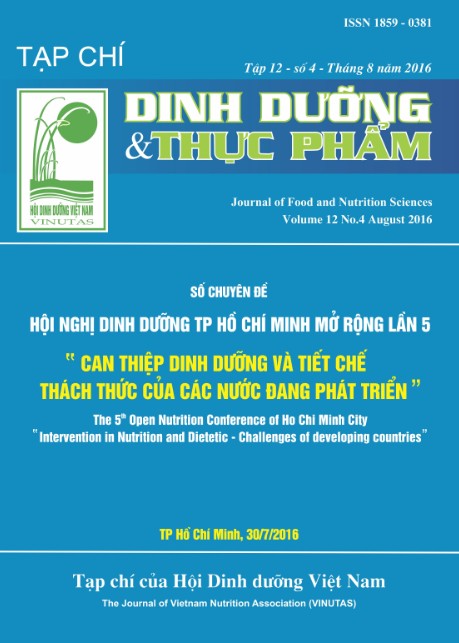CURRENT IODINE DEFICIENCY: OPPORTUNITIES AND CHALLENGES
Main Article Content
Abstract
Iodine deficiency is the main cause of preventable mental retardation in childhood. WHO recommended iodized salt utilization as a safe and effective approach to control iodine deficiency disorders. In Vietnam, National Iodine Deficiency Disorders Control Program was established from 1995-2005. Since 2005, this National program was changed to routine activities and the coverage of household iodized salt and median urinary iodine concentration have declined significantly. Viet Nam is now in a situation similar to that at the start of the program in 1995. Vietnamese people currently use a lot of salt condiments other than salt to cook foods such as fish sauce, seasoning granules which were not iodized. This may be one of the reasons for iodine deficiency of Vietnamese people. The study was successful in creating a formula and process approach to fortify iodine to the seasoning granules. This new approach might contribute to improve the status of iodine deficiency in the community.
Keywords
Iodine deficiency, iodized salt, iodized granule, program
Article Details
References
2. WHO/UNICEF/ICCIDD (2007). IDD and their control, and global progress in their elimination, Assessment of iodine deficiency disorders and monitoring their elimination, A guide for programme managers, 3: 6-16.
3. Benoist B, Andersson M, et al (2004). Iodine status worldwide. WHO global database on iodine deficiency: WHO, 1-4.
4. Maria Andersson, Vallikkannu Karumbunathan, et al (2012). Global iodine status in 2011 and trends over the past decade, J. Nutr, 142 (4): 744-750.
5. Lê Mỹ (1994). Chiến lược phủ muối iốt toàn quốc, Tạp chí các rối loạn do thiếu iốt, Bộ Y tế, 14: 7-8.
6. Trung tâm Dinh dưỡng TPHCM (1995). Báo cáo tình hình điều tra dịch tễ học bướu cổ tại 30 trường tiểu học TPHCM ở trẻ từ 8 – 11 tuổi, Hội nghị tổng kết chương trình Quốc gia phòng chống CRLTI TPHCM.
7. Trần Thị Minh Hạnh, Phạm Ngọc Oanh, et al (2008). Tình trạng thiếu iốt ở phụ nữ mang thai TPHCM, Tạp chí Y học TPHCM, chuyên đề Y tế Công cộng & Y học Dự phòng, 4(12):135-140
8. Trung tâm Dinh dưỡng TPHCM (2015). Thông báo kết quả giám sát muối iốt thường qui tại TPHCM năm 2015.
9. Benoist B, Andersson M, et al (2007). Iodine deficiency, health consequences, assessment and control. Iodine deficiency in Europe a continuing public health problem: WHO, UNICEF: 8-10.
10.WHO/UNICEF/ICCIDD (2008). The iodization process. Elimination of iodine deficiency disorders:EMRO technical publications series: 39-73.
11.Burgi H, Supersaxo Z, et al (1990). Iodine deficiency diseases in Switzerland one hundred years after Theodor Kocher's survey: a historical review with some new goitre prevalence data, Acta Endocrinology, 6 (123): 577-590.
12.Nancy J A, Minawaer A, Vanessa C, et al (2014). Effect and safety of salt iodization to prevent iodine deficiency disorders: a systematic review with meta-analyses, WHO: 9-11.
13.UNICEF (2013). Salt Iodisation in Viet Nam: Learning from the Past and Building Back Better:18-27
14.Trung tâm Dinh dưỡng TPHCM (2010). Thông báo kết quả giám sát muối iốt thường qui tại TPHCM năm 2010.
15.Ủy ban Nhân dân TPHCM (2013). Chiến lược Quốc gia về Dinh dưỡng-giai đoạn 2011-2015 và tầm nhìn đến năm 2020 của TPHCM: 8-11
16.Chính phủ (2016). Quy định về tăng cường vi chất dinh dưỡng vào thực phẩm. Nghị định số 09/2016/NĐ-CP
17.Đỗ Thị Ngọc Diệp, Tạ Thị La, Trần Thị Bích Vân, Phạm Ngọc Oanh, Vũ Tiến Dũng, et al (2015). Nghiên cứu bổ sung iốt vào hạt nêm góp phần cải thiện tình trạng thiếu hụt iốt trong cộng đồng, đề tài nghiên cứu cấp thành phố, Sở Khoa học Công nghệ & Môi trường: 64-72.


